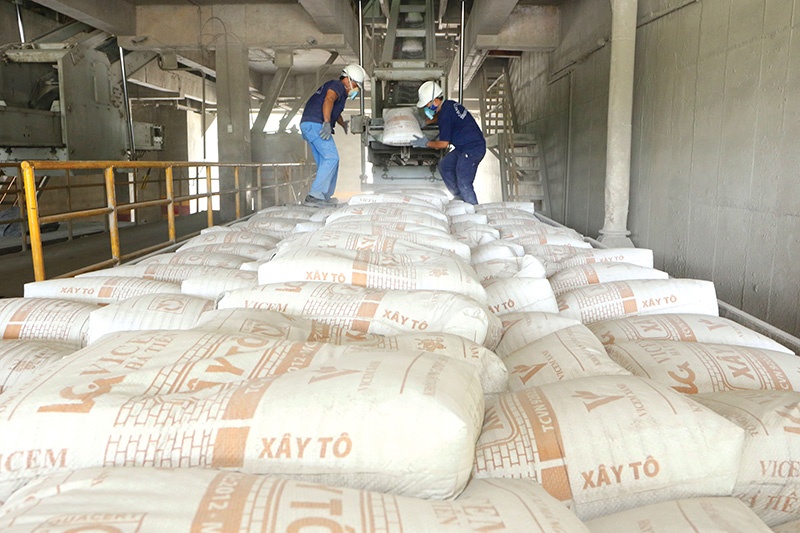Mixed picture for cement as more promotion urged
 |
| Mixed picture for cement as more promotion urged, photo Le Toan |
According to Nguyen Quang Cung, chairman of the Vietnam Cement Association (VCA), cement consumption is estimated to have reached 105.6 million tonnes in 2021, up about 2 per cent on-year, while the export turnover witnessed an increase by 5 per cent on-year.
“This is a positive number in the context of the pandemic, demonstrating the efforts of the state and businesses as well as the successful global integration of the industry. The cement industry is in a state of large oversupply, so export is the main channel to help the industry,” said Cung.
He explained that cement exports increased sharply in recent months because major export markets such as the EU, Canada, the US, and China have returned to normal operations, and the demand for cement along with the price has increased. This rise in exports has offset an overall decline in domestic consumption suffered last year.
Currently, Vietnam is ranked fifth globally in cement production capacity, only after China, India, the US, and Russia.
VNDirect Securities Company identified that cement inventories in China, were at the lowest level since the beginning of 2021, while selling prices have increased.
Meanwhile, in the domestic market, consumption volume improved in the last quarter, as construction works resumed after last summer’s restrictions. Along with that, with the government promoting disbursement of public investment capital, the areas of construction and building materials benefited.
Despite the positive signs, businesses are still dealing with a series of issues. A representative of one cement business in the northern province of Ha Nam shared that the export price of clinker was 10-17 per cent lower than the domestic selling price in 2021, but the businesses still had to sell the products because it was impossible to keep inventory.
“Most of Vietnam’s cement businesses use imported coal, but the price has increased. In addition, logistics costs remain high. Both of these factors can affect the export performance of related enterprises. For sustainable development, the industry still has a lot of work to do,” he added.
The coal prices on the world market have increased continuously since July, from $125 to $230 per tonne, putting great pressure on cement manufacturing companies, as the cost of coal accounts for 40-45 per cent of cement production.
Cung from the VCA said that if exports are not promoted, inventories of enterprises could expand greatly. Export cement output has increased, but the price abroad is fluctuating.
“The limited transport infrastructure and storage systems are also affecting many industries, including cement, increasing costs and harming the competitiveness of products,” Cung emphasised.
A series of listed cement firms have shown that profits were inversely proportional to output. For instance, Vicem But Son (code: BTS) reported Q3 business results with revenues down 14.6 per cent to VND657.3 billion ($28.58 million) and losses after tax of nearly VND8 billion ($350,000).
In the first nine months of 2021, revenues for Vicem reached VND2.1 trillion ($91.3 million), and profit after tax reached VND25.1 billion ($1 million), down 5.7 per cent and 47.2 per cent respectively over the same period in 2020.
In the same boat, Ha Tien 1 Cement JSC (code: HT1) recorded in Q3 VND5 trillion ($217 million) in net revenues and nearly VND317 billion ($13.8 million) in profit after tax, down 12 and 31 per cent, respectively, on-year.
State-owned Vietnam Cement Industry Corporation, Vietnam’s largest cement producer, has set modest goals for 2022 with production of clinker at nearly 22 billion tonnes, an increase of 2 per cent on-year.
What the stars mean:
★ Poor ★ ★ Promising ★★★ Good ★★★★ Very good ★★★★★ Exceptional
Related Contents
Latest News
More News
- Businesses ramp up production as year-end orders surge (December 30, 2025 | 10:05)
- Vietjet chairwoman awarded Labour Hero title (December 29, 2025 | 13:06)
- How to unlock ESG value through green innovation (December 29, 2025 | 10:03)
- AI reshapes media and advertising industry (December 29, 2025 | 08:33)
- FPT and GELEX sign deal to develop blockchain tech for global markets (December 29, 2025 | 08:29)
- Vietnam’s GDP forecast to grow by 9 per cent in 2026 (December 29, 2025 | 08:29)
- Women entrepreneurs are key to Vietnam’s economic growth (December 29, 2025 | 08:00)
- Vietnam's top 500 value-creating enterprises announced (December 27, 2025 | 08:00)
- The PAN Group shaping a better future with ESG strategy (December 26, 2025 | 09:00)
- Masan Consumer officially lists on HSX, marking the next phase of value creation (December 25, 2025 | 13:20)

 Tag:
Tag:





















 Mobile Version
Mobile Version